现在进行时表将来教学设计
- 格式:doc
- 大小:29.50 KB
- 文档页数:3
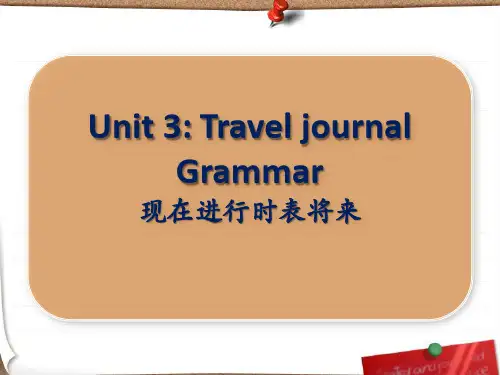
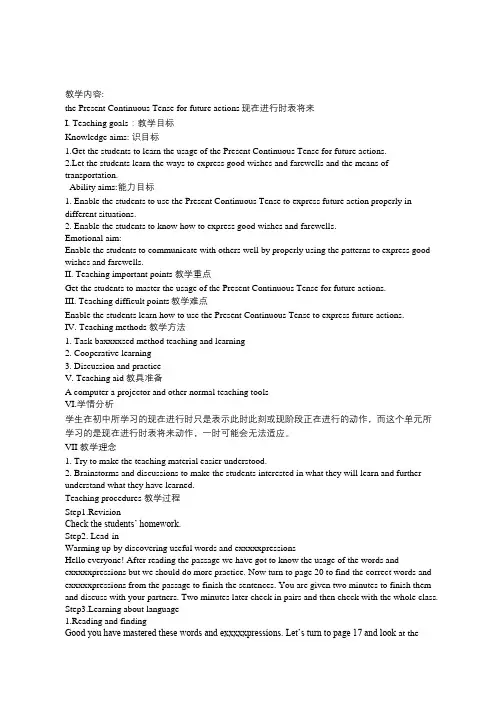
教学内容:the Present Continuous Tense for future actions现在进行时表将来I. Teaching goals:教学目标Knowledge aims: 识目标1.Get the students to learn the usage of the Present Continuous Tense for future actions.2.Let the students learn the ways to express good wishes and farewells and the means of transportation.Ability aims:能力目标1. Enable the students to use the Present Continuous Tense to express future action properly in different situations.2. Enable the students to know how to express good wishes and farewells.Emotional aim:Enable the students to communicate with others well by properly using the patterns to express good wishes and farewells.II. Teaching important points 教学重点Get the students to master the usage of the Present Continuous Tense for future actions.III. Teaching difficult points教学难点Enable the students learn how to use the Present Continuous Tense to express future actions.IV. Teaching methods 教学方法1. Task-baxxxxsed method teaching and learning2. Cooperative learning3. Discussion and practiceV. Teaching aid 教具准备A computer a projector and other normal teaching toolsVI.学情分析学生在初中所学习的现在进行时只是表示此时此刻或现阶段正在进行的动作,而这个单元所学习的是现在进行时表将来动作,一时可能会无法适应。
![现在进行时教学设计(一)[共五篇]](https://uimg.taocdn.com/5e8454e109a1284ac850ad02de80d4d8d15a0128.webp)
现在进行时教学设计(一)[共五篇]第一篇:现在进行时教学设计(一)现在进行时教学设计(一)一、教学目标1、让学生学会正确地使用现在进行时2、能综合的应用现在进行时完成任务3、通过这节课的学习,培养学生参与课堂教学的兴趣和积极性,以及培养他们运用语法知识的交际能力。
二、教学重点1、掌握现在进行时的概念和构成2、了解现在进行时的几种句型3、初步感受、运用一些简单的现在进行时态4、了解现在进行时和一般现在时的区别三、教学难点现在进行时的构成,能灵活的运用一些简单的现在进行时态四、教学准备1、准备教学课件2、课堂练习题、练习纸五、教学过程1、现在进行时的概念现在进行时表示说话时(瞬间)正在进行的动作,或现阶段一直进行的动作2、现在进行时的结构现在进行时的结构是:be(am, is, are)+动词的分词形式3、现在进行时的几种句型(1)陈述句(肯定句)主语+be(am, is, are)+现在分词,如:→I am reading English.我正在读英语。
→He is writing.他正在写字。
→You are running.你正在跑步。
(2)一般疑问句Be(Am, Is, Are)+主语+现在分词,如:①.-Are you singing?你正在唱歌吗?-Yes, I am.是的,我在唱歌。
(No, I'm not.不,我不在唱歌。
)②.-Is he(she)listening to music?他(她)在听音乐吗?-Yes, he(she)is.是的,他(她)在听音乐。
[No, he(she)isn't.不,他(她)不在听音乐。
](3)特殊疑问句疑问词+be(am, is, are)+主语+现在分词,如:①.-What are you doing?你正在做什么?-I am doing my homework.我正在做作业。
②.-What is he(she)doing?他(她)正在做什么?-He(She)is riding a bike.他(她)正在骑自行车。
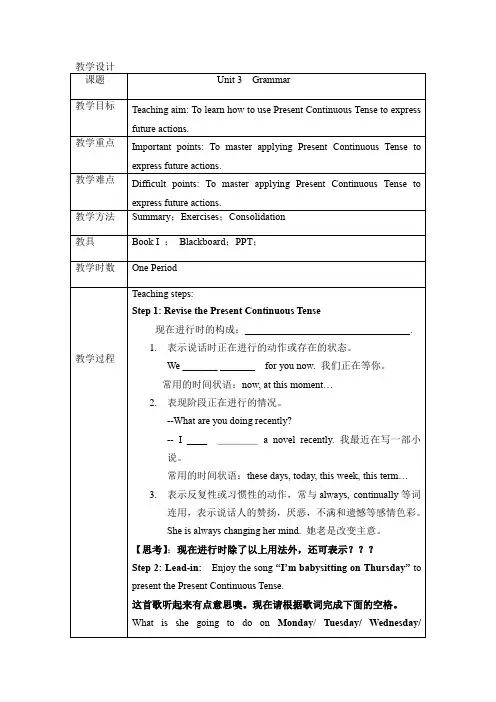
1.学生是高中生.2.学生已经学习了词汇(Vocabulary):journal, transport, prefer, disadvantage, fare, flow, persuade, cycle, graduate, finally, schedule, shortcoming, stubborn, organize, determine, journey, altitude, valley, pace, bend, attitude, boil, forecast, parcel, insurance, wool, reliable, view, pillow, midnight, flame, beneath, temple, cave. ..3学生对短语(Phrases and expressions):ever since,be fond of, care about. Change one’s mind, make up one’s mind, give in, as usual, at midnight.已经学习过。
4.学生对语法(Grammar)已经有所了解:掌握并能熟练应用现在进行时表将来。
5.学生思维活跃,善于和同学交流,乐于表达自己,渴望得到同学和教师的赞许;6.学生对英语学习有着浓厚的兴趣,擅长对本单元有关旅游的知识展开讨论;效果分析本节课是人教版必修一第3单元的语法课。
重点是学习本单元语法项目—现在进行时表将来。
通过本节课的讲解及最后的测评练习可以看出,大部分学生已掌握了本单元所学的现在进行时表将来。
能比较熟练、准确地使用这一时态表达未来一段时间的计划。
大部分学生能掌握现在进行时的其他用法及将来时的其他表达。
本单元讲述了一段沿湄公河而下的自行车旅行,主人公“王坤”以旅行日志的形式详细的记录了这一过程。
学生通过追随这一段旅程,探讨与“旅游”相关的各种话题。
本单元共分八个部分。
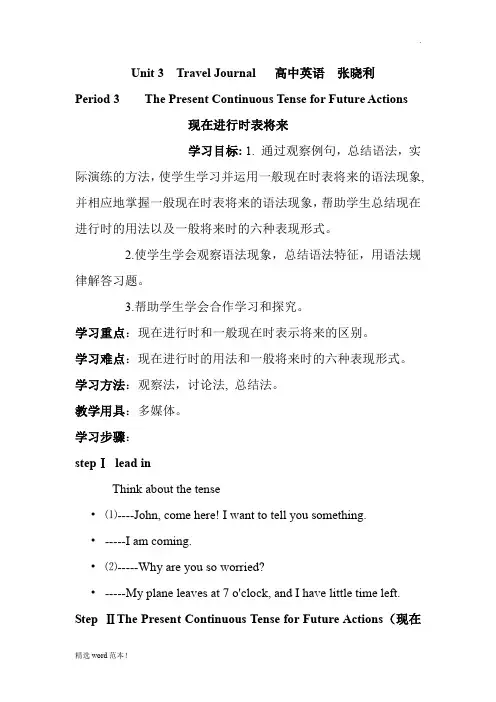
Unit 3 Travel Journal 高中英语张晓利Period 3 The Present Continuous Tense for Future Actions现在进行时表将来学习目标: 1. 通过观察例句,总结语法,实际演练的方法,使学生学习并运用一般现在时表将来的语法现象,并相应地掌握一般现在时表将来的语法现象,帮助学生总结现在进行时的用法以及一般将来时的六种表现形式。
2.使学生学会观察语法现象,总结语法特征,用语法规律解答习题。
3.帮助学生学会合作学习和探究。
学习重点:现在进行时和一般现在时表示将来的区别。
学习难点:现在进行时的用法和一般将来时的六种表现形式。
学习方法:观察法,讨论法, 总结法。
教学用具:多媒体。
学习步骤:stepⅠlead inThink about the tense•⑴----John, come here! I want to tell you something.•-----I am coming.•⑵-----Why are you so worried?•-----My plane leaves at 7 o'clock, and I have little time left. Step ⅡThe Present Continuous Tense for Future Actions(现在进行时表将来)1)Betty is leaving for Guangzhou by plane tomorrow.2)Bob is going to the airport by taxi next week.3) Jane is staying in Xi’an with her parents.4) Bob is coming with Betty to see her off.小结:此四句是现在进行时代替一般将来时,表示一个最近按计划或安排要进行的动作,这类动词通常是瞬间动作,只限于少数趋向性动词,常见的有:go, come, leave, arrive, return, stay, start, travel, fly, get to, see off, take off .Step ⅢThe Present Continuous Tense for the present actions:现在进行时表现在1)How are you feeling today?2)He is always helping others.3)You are always leaving things about(乱放).4)He is always talking big(吹牛).小结:此四句是现在进行时代替一般现在时,表示一个经常性重复的动作或状态,这时句中常带always 或forever,以表示说话人的某种感情,如赞叹,厌烦,埋怨等.Step Ⅳ一般现在时代替一般将来时1)The plane takes off at 9:30.2)My plane leaves at 7:00.3)When does the winter holiday begin?4)What time does the train leave for Shanghai?小结:此四句表示将来的事情按时刻表将要发生,不因主观情况而改变,则用一般现在时代替将来时,但仅限于少数动词begin, go, leave, start, take off 等。
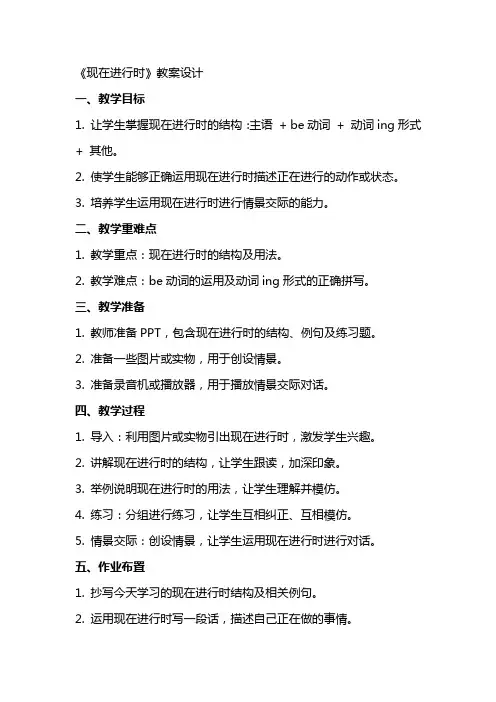
《现在进行时》教案设计一、教学目标1. 让学生掌握现在进行时的结构:主语+ be动词+ 动词ing形式+ 其他。
2. 使学生能够正确运用现在进行时描述正在进行的动作或状态。
3. 培养学生运用现在进行时进行情景交际的能力。
二、教学重难点1. 教学重点:现在进行时的结构及用法。
2. 教学难点:be动词的运用及动词ing形式的正确拼写。
三、教学准备1. 教师准备PPT,包含现在进行时的结构、例句及练习题。
2. 准备一些图片或实物,用于创设情景。
3. 准备录音机或播放器,用于播放情景交际对话。
四、教学过程1. 导入:利用图片或实物引出现在进行时,激发学生兴趣。
2. 讲解现在进行时的结构,让学生跟读,加深印象。
3. 举例说明现在进行时的用法,让学生理解并模仿。
4. 练习:分组进行练习,让学生互相纠正、互相模仿。
5. 情景交际:创设情景,让学生运用现在进行时进行对话。
五、作业布置1. 抄写今天学习的现在进行时结构及相关例句。
2. 运用现在进行时写一段话,描述自己正在做的事情。
3. 预习下节课内容,了解一般过去时的结构及用法。
六、教学评价1. 课堂表现评价:观察学生在课堂上的参与程度、发言积极性以及发音准确性。
2. 练习题评价:检查学生完成练习题的情况,纠正错误并给予反馈。
3. 情景交际评价:评估学生在情景交际中的表现,关注语法正确性和沟通流畅性。
七、拓展活动1. 小组游戏:设计一个游戏,让学生在游戏中运用现在进行时进行问答。
2. 角色扮演:让学生分组进行角色扮演,模拟不同场景下使用现在进行时的情景。
3. 听力练习:播放一段听力材料,要求学生用现在进行时回答相关问题。
八、课堂小结1. 回顾本节课所学内容,总结现在进行时的结构和使用场景。
2. 强调学生在日常交流中运用现在进行时的重要性。
3. 提醒学生注意现在进行时与一般现在时的区别。
九、课后反思1. 分析课堂教学效果,总结成功之处和改进空间。
2. 思考如何针对不同学生的学习程度进行更有效的教学。
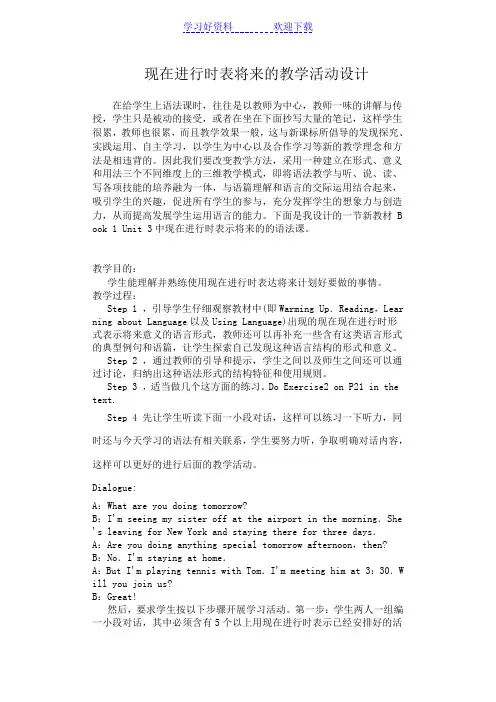
现在进行时表将来的教学活动设计在给学生上语法课时,往往是以教师为中心,教师一味的讲解与传授,学生只是被动的接受,或者在坐在下面抄写大量的笔记,这样学生很累,教师也很累,而且教学效果一般,这与新课标所倡导的发现探究、实践运用、自主学习,以学生为中心以及合作学习等新的教学理念和方法是相违背的。
因此我们要改变教学方法,采用一种建立在形式、意义和用法三个不同维度上的三维教学模式,即将语法教学与听、说、读、写各项技能的培养融为一体,与语篇理解和语言的交际运用结合起来,吸引学生的兴趣,促进所有学生的参与,充分发挥学生的想象力与创造力,从而提高发展学生运用语言的能力。
下面是我设计的一节新教材 B ook 1 Unit 3中现在进行时表示将来的的语法课。
教学目的:学生能理解并熟练使用现在进行时表达将来计划好要做的事情。
教学过程:Step 1 ,引导学生仔细观察教材中(即Warming Up.Reading,Lear ning about Language以及Using Language)出现的现在现在进行时形式表示将来意义的语言形式,教师还可以再补充一些含有这类语言形式的典型例句和语篇,让学生探索自己发现这种语言结构的形式和意义。
Step 2 ,通过教师的引导和提示,学生之间以及师生之间还可以通过讨论,归纳出这种语法形式的结构特征和使用规则。
Step 3 ,适当做几个这方面的练习。
Do Exercise2 on P21 in the text.Step 4 先让学生听读下面一小段对话,这样可以练习一下听力,同时还与今天学习的语法有相关联系,学生要努力听,争取明确对话内容,这样可以更好的进行后面的教学活动。
Dialogue:A:What are you doing tomorrow?B:I'm seeing my sister off at the airport in the morning.She 's leaving for New York and staying there for three days.A:Are you doing anything special tomorrow afternoon,then? B:No.I'm staying at home.A:But I'm playing tennis with Tom.I'm meeting him at 3:30.W ill you join us?B:Great!然后,要求学生按以下步骤开展学习活动。
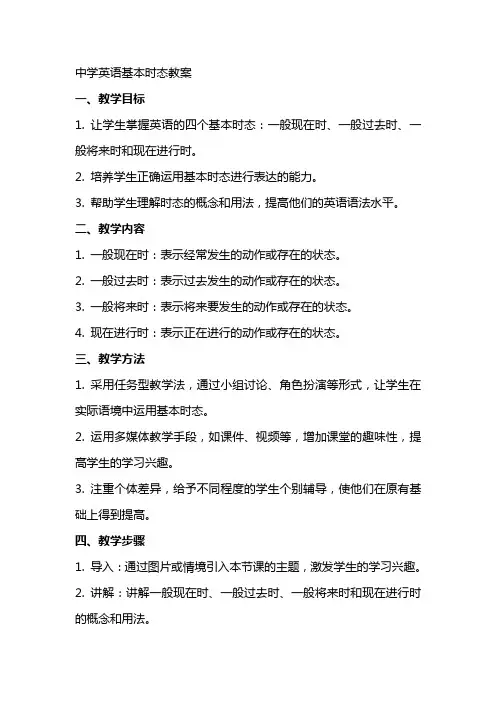
中学英语基本时态教案一、教学目标1. 让学生掌握英语的四个基本时态:一般现在时、一般过去时、一般将来时和现在进行时。
2. 培养学生正确运用基本时态进行表达的能力。
3. 帮助学生理解时态的概念和用法,提高他们的英语语法水平。
二、教学内容1. 一般现在时:表示经常发生的动作或存在的状态。
2. 一般过去时:表示过去发生的动作或存在的状态。
3. 一般将来时:表示将来要发生的动作或存在的状态。
4. 现在进行时:表示正在进行的动作或存在的状态。
三、教学方法1. 采用任务型教学法,通过小组讨论、角色扮演等形式,让学生在实际语境中运用基本时态。
2. 运用多媒体教学手段,如课件、视频等,增加课堂的趣味性,提高学生的学习兴趣。
3. 注重个体差异,给予不同程度的学生个别辅导,使他们在原有基础上得到提高。
四、教学步骤1. 导入:通过图片或情境引入本节课的主题,激发学生的学习兴趣。
2. 讲解:讲解一般现在时、一般过去时、一般将来时和现在进行时的概念和用法。
3. 举例:用具体的例子解释每个时态的用法,让学生清晰地理解。
4. 练习:设计相关的练习题,让学生进行书面和口头练习。
5. 小组活动:让学生分组进行讨论,运用所学时态进行交流。
6. 总结:对本节课的内容进行总结,强调重点和难点。
7. 作业:布置相关的作业,巩固所学知识。
五、教学评价1. 课后收集学生的作业,检查他们对基本时态的掌握情况。
2. 在下一节课开始时,让学生进行时态的口头测试,检验他们的实际运用能力。
3. 关注学生在课堂上的表现,观察他们是否能正确运用基本时态进行表达。
六、教学资源1. 课件:制作涵盖基本时态用法的课件,配以图表、例句和练习题。
2. 视频材料:选取相关时态的英语视频,让学生观看并模仿。
3. 练习册:提供一份包含各种练习的册子,以便学生课后巩固所学知识。
4. 小组活动用品:准备一些卡片或图片,用于小组活动中的角色扮演和讨论。
七、教学重点与难点1. 重点:让学生掌握四个基本时态的构成和用法。
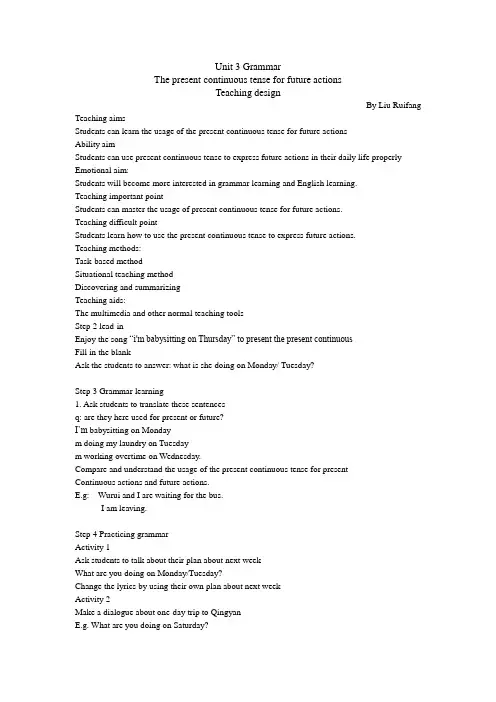
Unit 3 GrammarThe present continuous tense for future actionsTeaching designBy Liu Ruifang Teaching aimsStudents can learn the usage of the present continuous tense for future actionsAbility aimStudents can use present continuous tense to express future actions in their daily life properly Emotional aim:Students will become more interested in grammar learning and English learning.Teaching important pointStudents can master the usage of present continuous tense for future actions.Teaching difficult pointStudents learn how to use the present continuous tense to express future actions.Teaching methods:Task-based methodSituational teaching methodDiscovering and summarizingTeaching aids:The multimedia and other normal teaching toolsStep 2 lead-inEnjoy the song “i'm babysitting on Thursday” to present the present continuousFill in the blankAsk the students to answer: what is she doing on Monday/ Tuesday?Step 3 Grammar learning1. Ask students to translate these sentencesq: are they here used for present or future?I’m babysitting on Mondaym doing my laundry on Tuesdaym working overtime on Wednesday.Compare and understand the usage of the present continuous tense for presentContinuous actions and future actions.E.g: Wurui and I are waiting for the bus.I am leaving.Step 4 Practicing grammarActivity 1Ask students to talk about their plan about next weekWhat are you doing on Monday/Tuesday?Change the lyrics by using their own plan about next weekActivity 2Make a dialogue about one-day trip to QingyanE.g. What are you doing on Saturday?Who are you going with?When are you starting?What are you doingWhen are you returning?Step 4 Summary现在进行时可以用来表示将来位移动词come, leave, return, arrive, see off, start, travel, take非位移动词do, buy, met, have, play, finish, stay, publishStep 5 HomeworkPractice makes perfectChoose one (either 1 or 2)1. Change the lyrics by using your own plan and try to sing it.2. Set a situation to write a short passage by using the present continuous tense for future. Step 6 Teaching reflection。
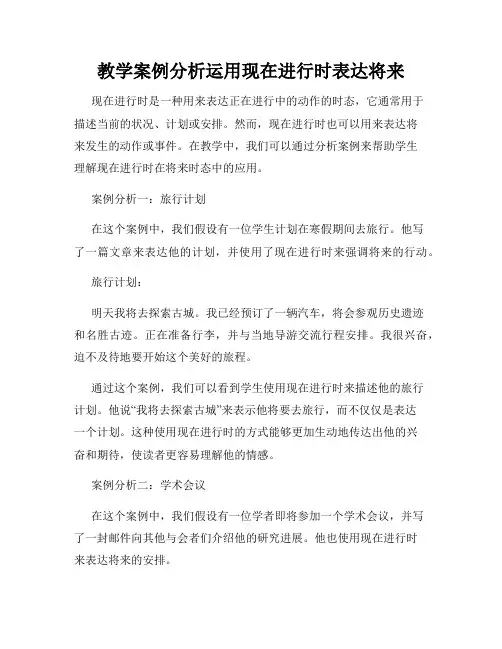
教学案例分析运用现在进行时表达将来现在进行时是一种用来表达正在进行中的动作的时态,它通常用于描述当前的状况、计划或安排。
然而,现在进行时也可以用来表达将来发生的动作或事件。
在教学中,我们可以通过分析案例来帮助学生理解现在进行时在将来时态中的应用。
案例分析一:旅行计划在这个案例中,我们假设有一位学生计划在寒假期间去旅行。
他写了一篇文章来表达他的计划,并使用了现在进行时来强调将来的行动。
旅行计划:明天我将去探索古城。
我已经预订了一辆汽车,将会参观历史遗迹和名胜古迹。
正在准备行李,并与当地导游交流行程安排。
我很兴奋,迫不及待地要开始这个美好的旅程。
通过这个案例,我们可以看到学生使用现在进行时来描述他的旅行计划。
他说“我将去探索古城”来表示他将要去旅行,而不仅仅是表达一个计划。
这种使用现在进行时的方式能够更加生动地传达出他的兴奋和期待,使读者更容易理解他的情感。
案例分析二:学术会议在这个案例中,我们假设有一位学者即将参加一个学术会议,并写了一封邮件向其他与会者们介绍他的研究进展。
他也使用现在进行时来表达将来的安排。
邮件内容:亲爱的同事们,我非常荣幸能够在本周末的学术会议上见到大家。
我目前正在准备演讲内容,并与我的团队合作,一起展示我们的研究成果。
我们正在整理数据、撰写报告,并准备展示所需的图表和实例。
我们已经申请了一个时间段,届时将向大家展示我们的研究发现。
我期待能够和大家分享我的研究成果,并与各位学者进行深入的交流。
通过这个案例,我们可以看到学者使用现在进行时来描述他的学术会议安排。
他说“我目前正在准备演讲内容”和“我们正在整理数据”来表示他正在进行的动作,以及他们团队的计划。
通过使用现在进行时来描述将来的行动,他能够更加生动地表达他的积极态度和期待。
通过以上两个案例的分析,我们可以看到在教学中运用现在进行时来表达将来时态是非常有效的。
这种方式能够使学生更好地理解现在进行时的用法,同时也能够帮助他们在写作和口语表达中更加地灵活运用现在进行时。

现在进行时表将来的教学活动设计在给学生上语法课时,往往是以教师为中心,教师一味的讲解与传授,学生只是被动的接受,或者在坐在下面抄写大量的笔记,这样学生很累,教师也很累,而且教学效果一般,这与新课标所倡导的发现探究、实践运用、自主学习,以学生为中心以及合作学习等新的教学理念和方法是相违背的。
因此我们要改变教学方法,采用一种建立在形式、意义和用法三个不同维度上的三维教学模式,即将语法教学与听、说、读、写各项技能的培养融为一体,与语篇理解和语言的交际运用结合起来,吸引学生的兴趣,促进所有学生的参与,充分发挥学生的想象力与创造力,从而提高发展学生运用语言的能力。
下面是我设计的一节新教材 B ook 1 Unit 3中现在进行时表示将来的的语法课。
教学目的:学生能理解并熟练使用现在进行时表达将来计划好要做的事情。
教学过程:Step 1 ,引导学生仔细观察教材中(即Warming Up.Reading,Learn ing about Language以及Using Language)出现的现在现在进行时形式表示将来意义的语言形式,教师还可以再补充一些含有这类语言形式的典型例句和语篇,让学生探索自己发现这种语言结构的形式和意义。
Step 2 ,通过教师的引导和提示,学生之间以及师生之间还可以通过讨论,归纳出这种语法形式的结构特征和使用规则。
Step 3 ,适当做几个这方面的练习。
Do Exercise2 on P21 in the text.Step 4 先让学生听读下面一小段对话,这样可以练习一下听力,同时还与今天学习的语法有相关联系,学生要努力听,争取明确对话内容,这样可以更好的进行后面的教学活动。
Dialogue:A:What are you doing tomorrow?B:I'm seeing my sister off at the airport in the morning.She 's leaving for New York and staying there for three days.A:Are you doing anything special tomorrow afternoon,then? B:No.I'm staying at home.A:But I'm playing tennis with Tom.I'm meeting him at 3:30.W ill you join us?B:Great!然后,要求学生按以下步骤开展学习活动。
现在进⾏时表将来教学设计现在进⾏时表将来教学设计Teaching Aims:Knowledge aim: use the Present Progressive Tense to talk about future plan correctly.Skill aim: students know how to talk future plans.Important points: 1. the structure of the Present Progressive Tense.2. Get the students know the different kinds of verbs that used in structure.3. use the Present Progressive Tense to talk about future plan.Difficult point: use the Present Progressive Tense to talk about the future plan.Teaching Procedure:The telephone is ringing , would you answer it?电话正在响,请你接⼀下,好吗?The boy is jumping with joy.那个⼩男孩正⾼兴的跳呢。
现在进⾏时的结构是be+doing,它的基本⽤法是表⽰此时此刻正在进⾏的动作。
看看下⾯的句⼦应该怎么理解呢?1.What are you doing next Sunday?下个星期天你打算⼲什么呢?2.She is buying a new car next month.她下个⽉将要买⼀辆新车。
3.I’m not waiting any longer.我将不再等了。
当句⼦涉及确切的计划、明确的意图和为将来安排好的活动时,现在进⾏时可⽤来表⽰将来。
现在进⾏时表将来句⼦中谓语动词分四类:1.常与瞬间动词连⽤。
现在进行时表将来的说课稿现在进行时表将来的说课稿沽源一中邓桃I Type of the class:Grammar—the Present Continuous Tense to talk about future planII Analysis of the teaching material:This unit we are going to learn the grammar —the Present Continuous Tense to talk about future plan. Students has learned V+ing, that is, the Present Continuous Tense, but they don’t know exactly what it is used for. So in this class we will review the basic usages of the Present Continuous Tense and introduce a new usage —the Present Continuous Tense to talk about future plan.III Analysis of the students:Because it’s not a long time since the students came into high school, it is a little difficult for them to grasp difficult grammar. So we should begin with the simple the Present Continuous Tense to lead in. Since they are poor in English, they are not good at spoken English. Of course, they do need encouragement.Iv Teaching aims:Knowledge aim: use the Present Continuous Tense to talk about future plan correctly. Ability aim: students know how to talk future plans.Emotion aim: the student learn to cooperate and be brave.V Important points: 1 the structure of the present Continuous Tense.2 Words used to express future plans3 use the present Continuous Tense to talk about future plans.Difficult point : use the present Continuous Tense to talk about future plans. VI Teaching method: cooperation, pair-work.VII Teaching aids: blackboard.VIII Teaching Procedure:Step 1: Greet students.Step 2: Lead-in.Show some pictures to the students and ask some of them to describe what they are doing.1For example:--What is he/she doing?--He is …以上句子中出现的时态是_______________, 其构成是__________________。
教学内容现在进行时表将来教学目标1)掌握现在进行时表将来的用法2)区别词教学重、难点重点: 现在进行时表将来的用法难点: 区别词、考点STEP1: Oral English (口语)能力训练一、补全对话小明生病了,他流鼻涕,还不停的咳嗽。
现在他正在看医生,请阅读并补全他们的对话。
A: I'm not feeling well, doctor.B: What's the 1?A: Well, I have a runny nose and I 2stop coughing.B: You have 3 a cold.Take some medicine and 4 a good sleep.You'll 5better soon.A: Thank you doctor.二、连词成句5. 我相信每天晚上8个小时的睡眠很重要。
I believe that it’s ___________ _________ sleep 8 hours each night.STEP2: 区别词的用法1. wish和hope 的区别2. That sounds nice.听起来不错。
1)sound 是动词,意思是: 听起来, 发出声音:. 听起来很有意思。
.听起来太好了。
Your idea sounds a good one. 你的想法听起来很好。
2)sound 还可以作名词,表示“声音,响声” 例如:.光比声音快。
鸟儿歌唱的声音。
I just finished . 我刚刚拍摄完我的最后一个电影。
film v. 拍电影finish doing something做完某事例如:When we finished cleaning our classroom, we went home.练习:用所给的词的正确形式填空。
1. A: What are you doing for vacation?STEP3:语法解析1. 现在进行时表示将来当一个句子的意思涉及一个计划好的事件或者明确的意图时, 用现在进行时可以表示将来时间.现在进行时的将来意义或者通过时间副词或者通过上下文来暗示出来.现在进行时表将来时常有“意图”,“安排”(但不是固定不变的)或“打算”的含义。
现在进行时表将来教学设计教学内容:the Present Continuous Tense for future actions现在进行时表将来教学目标:1. Get the students to learn the usage of the Present Continuous Tense for future actions.2. Enable the students to use the Present Continuous Tense to express future action properly in different situations.教学重点:Get the students to master the usage of the Present Continuous Tense for future actions.教学难点:Enable the students learn how to use the Present Continuous Tense to express future actions.教学方法:1. Task-based method teaching and learning2. Cooperative learning3. Discussion and practice教学过程:Step1 Revision1. 复习现在进行时:表示现在( 指说话人说话时) 正在发生的事情或者正在进行的动作构成:is/am/are+V-ing练习:用现在进行时造句2.复习一般将来时:表示即将发生、打算要做的动作、状态等构成:be going to+V原,Will/shall+ V原练习:用所给单词的适当形式填空;1. There ______(be) an American film next week.2. Tom _______(play) football with us tomorrow.3. Next week we ________(have) an English party.4. She begins________(do) her homework in the afternoon.5. In my dream school there won’t be ________(some) dirty classrooms.6. Tom ________(go) back to Australia in three days.7. The radio says it _______(rain) later on Tuesday.Step2 Reading and finding1.引导学生仔细观察教材中(即Warming Up.Reading,Learning about Language以及Using Language)出现的现在现在进行时形式表示将来意义的语言形式,教师还可以再补充一些含有这类语言形式的典型例句和语篇,让学生探索自己发现这种语言结构的形式和意义.2. 通过教师的引导和提示,学生之间以及师生之间还可以通过讨论,归纳出这种语法形式的结构特征和使用规则。
学习过程一、复习预习讲解上节课布置的作业与练习,以到达复习上节课知识点的目的;接着给学生们一些如今时、将来时、如今时表将来时的简单的单项选择题,让学生们考虑并给出答案,并请学生自己解析为什么做出这样的选择,教师暂时不去解析,让学生们形成独立考虑的才能,同时引导学生发现问题。
二、知识讲解知识点1:如今进展时表示将来如今进展时表示将来,主要用于表示按方案或安排要发生的动作。
常有“意图〞“安排〞或“打算〞的含义。
这种如今进展时比拟生动,给人一种期待感。
能这样用的动词常用的有:arrive, come, do, get, go, have, leave, meet, play, return, see, spend, start, stay, wear, work 等。
1【考察点】come, go, stay, arrive, leave 等词的如今进展时经常用来表示将来确切的方案。
I’m leaving tomorrow. 我明天走。
2【考察点】表示交通方式、行程安排的动词,例如fly,walk, ride, drive, take(a bus, a taxi)等的如今进展时也经常用于表示将来。
但偶然也表示较远的将来。
如:When I grow up, I’m joini ng the army. 我长大了要参军。
3【考察点】表将来的如今进展时有时含有“决心〞的意思,多用在否认构造中。
如:I’m not going. 我不走了。
I’m not waiting any longer. 我不再等了。
有时也用在肯定构造中。
如:I’m backing out. 我要打退堂鼓了。
4【考察点】用这种如今进展时与对方讲话时可变成命令,不过语气比拟温和。
You are staying. 你留下吧。
Don’t forget: y ou are taking part too. 不要忘记:你也要参加。
5【考察点】如今进展时也可在时间、条件或原因状语从句中表示将来。
现在进行时表将来教学设计
Teaching Aims:
Knowledge aim: use the Present Progressive Tense to talk about future plan correctly.
Skill aim: students know how to talk future plans.
Important points: 1. the structure of the Present Progressive Tense.
2. Get the students know the different kinds of verbs that used in structure.
3. use the Present Progressive Tense to talk about future plan.
Difficult point: use the Present Progressive Tense to talk about the future plan.
Teaching Procedure:
The telephone is ringing , would you answer it?
电话正在响,请你接一下,好吗?
The boy is jumping with joy.
那个小男孩正高兴的跳呢。
现在进行时的结构是be+doing,它的基本用法是表示此时此刻正在进行的动作。
看看下面的句子应该怎么理解呢?
1.What are you doing next Sunday?
下个星期天你打算干什么呢?
2.She is buying a new car next month.
她下个月将要买一辆新车。
3.I’m not waiting any longer.
我将不再等了。
当句子涉及确切的计划、明确的意图和为将来安排好的活动时,现在进行时可用来表示将来。
现在进行时表将来句子中谓语动词分四类:
1.常与瞬间动词连用。
比如:come ,go, arrive,
leave, start, return等。
The train is arriving.
火车将要进站了。
He is coming back tomorrow.
他明天(将要)回来。
2.常与表示交通方式、行程安排的动词连用。
比如:walk, ride, fly, drive, take (a bus, a train) 等。
They are flying to Beijing next week.
他们下周(将)要飞往北京。
3.与表示位置的词连用。
如:stay, remain等。
I’m staying at home tonight.
我今晚打算呆在家里。
4.与少数其它动词连用。
如:do, have, visit, buy, meet等。
I’m meeting you after school. 放学后我要去找你。
学后练习
翻译下面的句子:
1.你将在上海呆多长时间?
2.你假期打算做什么?
3.今晚我打算在家看电视。